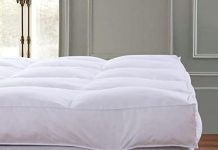Ever wondered why your once perfectly firm and supportive mattress eventually starts to sink and sag? It’s a common issue that many of us face, but have you ever stopped to wonder what causes this frustrating phenomenon? As we delve into this article, we will uncover the secrets behind mattress sagging, exploring the various factors that contribute to this common problem. From wear and tear to improper maintenance, we’ll shed light on the reasons behind the decline in mattress quality over time. So, if you’re tired of waking up with a sore back and longing for a rejuvenating night’s sleep, join us as we uncover the mysteries of mattress sagging and discover how you can prevent it.
Review contents
Material Degradation
Low-Quality Materials
One of the main reasons why mattresses may sag over time is the use of low-quality materials in their construction. When mattresses are made with subpar materials, they are more likely to wear down and lose their shape faster. The cheap foam or springs used in these mattresses may not provide adequate support or durability, leading to sagging in certain areas.
Wear and Tear
Another factor that can contribute to mattress sagging is wear and tear. Over years of use, our mattresses endure a significant amount of pressure, movement, and weight. This constant stress can cause the materials to break down and compress, resulting in sagging. Additionally, factors such as jumping on the bed, having pets on the mattress, or regularly sitting on the edges can accelerate wear and tear.
Moisture Damage
Moisture can also play a role in the degradation of mattresses. If a mattress is exposed to excessive moisture, either from spills, accidents, or high humidity levels, it can lead to the growth of mold, mildew, or bacteria. These contaminants can gradually weaken the mattress materials, causing them to sag. It is important to keep the mattress dry and maintain a proper level of ventilation to prevent moisture damage.
Inadequate Support
Insufficient Box Spring
The support system beneath the mattress is crucial for maintaining its shape and preventing sagging. If a mattress is placed on an inadequate or worn-out box spring, it may not provide the necessary support evenly across the surface. This can result in uneven weight distribution and eventual sagging in certain areas of the mattress. It is essential to ensure that the box spring is in good condition and matches the requirements of the mattress.
Weak Bed Frame
A weak or improperly constructed bed frame can also contribute to mattress sagging. The bed frame serves as the foundation for the mattress, and if it is weak or damaged, it may not be able to properly support the weight and pressure exerted on the mattress. This can lead to uneven support and sagging. Investing in a sturdy and well-built bed frame is essential to prevent this issue.
Improper Center Support
Mattresses, especially larger sizes such as queen or king, require proper center support to prevent sagging in the middle. Without adequate support in the center, the weight of the mattress and the sleeper can cause it to curve downwards over time. Using a center support beam or leg in conjunction with a supportive bed frame can help distribute the weight evenly and reduce the risk of sagging.
Overloading
Excessive Weight
It’s important to consider the weight that a mattress can handle. If a mattress is consistently subjected to excessive weight, it can lead to premature sagging. This can happen when the weight of multiple individuals or heavy objects exceeds the mattress’s recommended weight limit. It is advisable to check the manufacturer’s guidelines for weight capacity and avoid overloading the mattress to maintain its integrity.
Irregular Weight Distribution
In addition to excessive weight, an irregular distribution of weight on the mattress can contribute to sagging. This often occurs when individuals consistently sleep in the same position or on the same side of the bed. Over time, this continual pressure on specific areas can cause the materials to break down, resulting in sagging. Encouraging regular rotation and changing sleeping positions can help distribute the weight more evenly and prolong the life of the mattress.
Lack of Rotation
Neglecting Rotation
Failing to rotate the mattress regularly can also lead to sagging. When a mattress is consistently used without being rotated, the same areas bear the majority of the weight and pressure. This can cause the materials in those specific areas to break down more quickly, leading to sagging. Rotating the mattress every three to six months ensures that the weight is distributed evenly and reduces the risk of sagging.
Uneven Wear
If a mattress is not rotated regularly, it can result in uneven wear. The areas that support the most weight will likely experience more compression and degradation, while the unused areas remain relatively unaffected. This uneven wear can cause the mattress to sag in specific spots, affecting its overall comfort and support. By regularly rotating the mattress, the wear is spread out more evenly, minimizing the risk of sagging.
Improper Maintenance
Neglecting Cleaning
Proper maintenance of a mattress includes regular cleaning and removal of dust, allergens, and dirt. Neglecting these cleaning routines can contribute to the degradation of the mattress materials and increase the chances of sagging. Accumulated debris can weaken the fibers or create an environment for mold and bacteria growth, leading to structural damage. Following the manufacturer’s cleaning instructions and maintaining a clean sleep environment can help prevent sagging.
Ignoring Manufacturer Instructions
Each mattress comes with specific manufacturer instructions to ensure its longevity and performance. Ignoring or not following these instructions can result in premature sagging. Instructions may include guidelines on weight limits, recommended rotations, cleaning methods, and more. By disregarding these instructions, we risk compromising the structural integrity of the mattress and increasing the likelihood of sagging. It is important to read and adhere to the manufacturer’s recommendations to maximize the lifespan of the mattress.
Natural Wear and Tear
Compression of Filling Material
Over time, the filling materials inside a mattress, such as foam or fiber, can compress and lose their original shape. This natural wear and tear can occur due to the weight and pressure we apply to the mattress during sleep. As the filling materials compress, the mattress may develop indentations or sagging in these areas. While this is a normal part of a mattress’s lifespan, choosing a mattress with high-quality and durable filling materials can help slow down the process.
Natural Settlement of Coils
Mattresses that contain coils or springs may experience natural settlement over time. This settling occurs as the coils adjust to the weight and pressure applied, and it can result in slight sagging. While some settlement is expected, excessive sagging may indicate a problem with the coils or a structural issue. Regularly rotating the mattress and ensuring proper support can help minimize any adverse effects caused by natural coil settlement.
In conclusion, mattresses can sag over time due to a variety of factors, including low-quality materials, wear and tear, moisture damage, inadequate support, overloading, lack of rotation, improper maintenance, and natural wear and tear. By understanding these causes and taking appropriate measures such as investing in high-quality mattresses, maintaining proper support systems, and following manufacturer instructions for cleaning and maintenance, we can extend the lifespan of our mattresses and enjoy a comfortable and supportive sleep surface for years to come.
























